out of stock

Antifouling primer - gray aluminium - 750ml - Yachtcare
Part № 155857
Description
YACHTCARE Aluminium Grey Antifouling Primer - 750ml, This is a one - component primer containing aluminium pigments that act as an interface between old and new antifouling. It will create an impermeable barrier on submerged surfaces.
Specifications
Ean/Barcode
Application
Yield: 8m2/l (at 50u dry per coat) Capacity: 750ml Packaging : 1 x Antifouling primer grey aluminium YACHTCARE - 750ml Delivered in its original packaging
Size (L / ml / g / gal /oz)
Primer colour
Aluminium gray
- Practical Boat Owner
- Digital edition

Antifouling: Everything you need to know
- October 31, 2023
Our all-inclusive guide to preparing for, choosing and using antifouling paints

Choosing the right antifouling and applying it well is essential for your boat’s performance. A serviced engine , new sails and carefully tensioned rigging are all worthless if you have a coral reef growing on the bottom of your boat.
Even moderate fouling can easily lose you a knot or more of boat speed. But how much preparation does your boat need? Which paint is best and what’s the best way to apply it?
After a few years the thickness of paint on your boat’s bottom will inevitably have built up to the point where it has to be stripped back to the bare hull to start from scratch.

We test DIY methods for scraping, stripping, peeling and blasting old antifouling off the hull. But not all boats will need to do this!
It’s generally recommended that you do this every four to five years with self-eroding antifouling. The good news is that the more antifouling there is on the boat, the easier it is to remove, so it pays to wait a few years between attempts.
First of all, take a good look at the surface of the old paint. Self-eroding antifouling should, as the name suggests, gently remove most of itself during the year – but hard antifouling and many layers of eroding antifouling will eventually build up.
When to scrape off old antifouling There are craters where layers of old paint mean the boat’s bottom resembles a moonscape. There is flaking where patches of paint have peeled off to leave ragged edges. There are blisters where water is trapped under a bubble of paint – usually diagnosed by it being easy to pop. If you suspect the blisters are osmosis, get them checked out by an expert.
If the bottom isn’t too bad, you can probably leave taking it all off for another year and just do some minimal preparation this year, preparing the surface and keying it, to take the new paint.
Article continues below…

Removing antifouling – the job I’ll never do again!
After a season on the water and two years in a boatyard, Maximus’s antifouling was old and flaky. We’d been…

How to antifoul a boat: What we learned from antifouling Maximus
As we’d scraped back the hull and were starting afresh, the idea of releasing biocides into the water, albeit very…
Removing antifouling
If the bottom’s in a bad way, it’s clearly time to take the paint off. First, a warning: removing antifouling is not a pleasant DIY job. You’ll rarely meet a boat owner who has enjoyed the experience, and some pay a professional blasting company to come and do the job for them.
But for most of us, economy dictates that doing it yourself is the only way. PBO tested the various methods out on the bottom of Gallant a Sigma 38. The bottom wasn’t too bad, but 21 years of paint had left it pitted in some places, and the performance of the antifouling left a lot to be desired.
Owner Paul Fenner, with plans for a season of racing this year, wanted to know the best method to remove the old paint.
We headed to the Elephant Boatyard on the Hamble River armed with the three main DIY removal methods available:
- Dry scraping
- Chemical stripping
- DIY soda blasting
We taped out a test grid halfway down Gallant ‘s port side and set to work, dressed to the nines in overalls, gloves, eye protection and face masks. It’s a lovely job!
It’s worth repeating: afterwards, you’ll need to key the surface before painting.

After six hours, the RemovAll had bitten through the top layer of paint
Removing antifouling – Method 1. Dry scraping
Scraping is the cheapest way to take paint off. But which is the best scraper to use? We tried three – a traditional flat-bladed ‘push’ scraper, a triangular paint scraper and a Bahco ‘pull’ scraper with tungsten-carbide blades.
Flat-bladed scraper
Sharpened on a grinding wheel and with the corners ground off, the flat-bladed scraper was good for lifting flakes of paint off.
But for heavy-duty scraping it had a tendency to dig in and try to gouge the gel coat.
Triangular scraper
Sharpened on a grinding wheel and with its pointed corners ground off, the triangular scraper made light work of 21 years’ worth of paint.
An advantage is that you have three scraping surfaces to work with, which gives you extra time before it needs sharpening with a file. But it still needed frequent sharpening.
Bahco scraper
The Bahco scraper uses a reversible tungsten-carbide blade. It was so sharp it shaved the paint off unless you got the blade right underneath the paint layer, and its uber-sharp edges had a tendency to bite into the paint.
But it was probably the most effective. Larger versions have a knob on top for two-handed work that allows you to put a lot of force into it. The tungsten-carbide blade stayed sharp for longer than those of the triangular scraper.

Hi-tech scrapers
PBO reader Philip Stevens uses a Bosch PSE180E electric scraper with the blade’s corners rounded off. It’s no longer made by Bosch but can still be found for sale online.
Cheaper alternatives are sometimes available in discount stores like Lidl and Aldi.
‘It takes a while to get a feel for the correct angles of use but is much easier and cleaner to use than a manual scraper,’ says Philip. ‘A friend did the bottom of his 11.3m (37ft) Moody in a few days.’

Buy it now on Gael Force Marine
Note: We may earn a commission when you buy through links on our site, at no extra cost to you. This doesn’t affect our editorial independence.

PBO VERDICT: Best dry scraper on test
Scraping is quick but very labour intensive. The Bahco was the best, but the triangular scraper was effective – just keep those blades sharp!
TIPS FOR DRY SCRAPING
Round the corners off the blades with a file or on a grinding wheel. This will stop them digging into the gel coat.
Keep the blade sharp with a file or change the blades regularly. Hacking away with a blunt blade is just a waste of your energy.
Yards like you to clean up after yourself. Lay garden fleece, as used for protecting plants from frost, on the ground first. Water drains through, but dust and scrapings are left behind. At the end of the day you can bundle everything up and throw it away.
Removing antifouling – Method 2. Chemical stripping
An option which takes some of the effort out of scraping is to use chemicals to strip the paint.
You can’t just use any old paint stripper though – it has to be one safe for use on GRP.
We tried the three most readily available recommended products: International Paint’s Interstrip AF, Owatrol’s Marine Strip (formerly called Dilunet) and Removall 620 from Cirrus Systems.
Interstrip AF
PRICE: £23.99 for a 1 litre tin
This product is specifically formulated for removing antifouling. The tin’s instructions recommend leaving the product on for 10 minutes before scraping it off with a blunt wooden scraper.
‘This is fine if the antifouling being removed is thin,’ says International’s Richard Jerram, ‘But for thicker layers I would recommend that the Interstrip is left on much longer, even overnight’.
He goes to say that if leaving it overnight a covering of cling film stops the solvent from evaporating and keeps it moist overnight.
We tried scraping after 10 minutes, and the Interstrip had eaten away at the first two layers of paint. We found the best tool was in fact a plastic scraper of the type used to apply filler.
Leaving the stripper to work for 10 minutes each time, we got down to the primer after three applications. The Interstrip will leave the primer untouched, ready for the new coat of antifouling.
The tin recommends cleaning up any remaining antifouling with Thinners No3 – which worked but also started to remove the primer underneath. Finally a quick wet sand prepared the surface for the new antifouling.
PBO VERDICT: Quick but messy, and the fastest-acting of all the strippers we tried. Left the primer intact beneath the paint.
Buy it now on Amazon
RemovALL 620
PRICE: £36.60 for a 3.8 litre tub
Removall is environmentally friendly and safe on your skin. Depending on temperature, youleave it to work for 1-6 hours.
After four hours it had softened the top layer of paint, but nothing underneath, so we applied more and left it overnight. In the morning, the paint had begun to lift, so we scraped it off with a plastic scraper. It took off all the paint down to the primer.
A further application would have revealed the epoxy coating on top of the gel coat. It was viscous enough to not drip when applied.
The instructions say it can be simply blasted off with a pressure- washer. This worked for a few layers, but in our case would have needed another application if we weren’t to resort to a scraper.
PBO VERDICT: Slower acting than Interstrip. Environmentally friendly. Left the primer intact beneath the paint.
Owatrol Marine Strip
PRICE: £17.95 for a 1 litre pot
Marine Strip is sold in most chandleries. It requires 12 hours at least to eat through antifouling, so we applied it and came back the next day.
When applying, it was viscous enough not to drip. The instructions say to wait until the paint changes colour.
After a few hours, it had darkened and had softened the top layers of paint, but 12 hours later, it was really dark. With a plastic scraper we could then remove all the paint layers down to the primer.
It left the primer dry, which would need wet sanding, or another coat of the stripper, before more paint could be applied over the top.
It came off as easily as the Removall, in soft strips. Like the Removall, it can be pressure-washed off, though this was not as effective as scraping.
PBO VERDICT: Slower working and dried the primer out more than Removall, but the paint came off in bigger sheets.

A blunt wooden scraper removed the paint – but a thin plastic one proved more effective
TIPS FOR CHEMICAL STRIPPING
If leaving for extended periods, ie overnight, cover applied areas with cling film to stop the chemical drying out.
Wear eye, hand and body protection. Chemical strippers can burn!
Use synthetic-bristled brushes
Especially where there are many layers of antifouling, you may need a number of applications. Chemicals work better in warmer weather.

The kit comprises a ‘pot’ of soda, and you’ll need to hire a compressor
Removing antifouling – Method 3: DIY Soda blasting
PRICE: SODA POT £159.95 £29.95 per bag of soda
COVERAGE: 1sq m per bag
Most people bring in the experts to blast off their old stuff, but one way to keep costs down is by doing it yourself.
Yorkshire-based company Millar Soda Blasting supply soda ‘pots’ and the accompanying soda which, when coupled with a suitable compressor, lets you do your own blasting.
Company owner Michael Millar made the trip down south to demonstrate the unit. We had a relatively low-powered 13cfm compressor, which meant that the unit’s nozzle had to be small. A larger compressor would mean you could use a larger nozzle.
The soda explodes on contact with the hull, removing antifouling without damaging the GRP. It ate effortlessly through the layers of paint and primer, leaving the epoxy coating intact, and was by far the least labour-intensive of all the methods we tried.

The DIY soda blasting option was slow but effortless. A compressor with a bigger capacity would speed things up significantly
Using the small nozzle it took Michael five minutes to strip a rectangle 15cm x 25cm. We also tried it on another boat’s keel, which was brought back to bright metal quickly and easily, with a residual layer of soda that will protect the metal for up to six weeks.
Hard medium can also be added to the soda mix if you need to blast away more than paint.
PBO VERDICT: A slow but easy way to remove antifouling. You could save money by grouping together with fellow boat owners to share a blasting unit. Hiring a large compressor (30-40cfm) would make the job much quicker.
Buy it now on eBay
Overall verdict: Best DIY method for removing antifouling
Scraping was by far the cheapest and quickest way – but it’s labour-intensive, creates lots of dust and you run the risk of scratching the underlying gel coat.
The chemical strippers were messy and expensive, but did the job well. The ability to paint on and leave overnight makes the job of scraping the hull next day far easier than dry scraping.
And finally, soda blasting is the least labour-intensive – but was extremely slow. A bigger compressor would sort that out.
It’s cheaper than getting someone else to do it – but takes time. If you can afford it, paying someone else to blast it off might not be a bad idea!
For a more in-depth look at removing antifoul , read James Wood’s account of removing the antifoul from the PBO Project Boat, Maximus.
Antifouling preparation
If your boat’s bottom has a half-decent finish, you may be able to postpone the job of removing the old antifouling, but you will need to key the surface to ensure that the next layer of antifouling sticks to it.
Note: Even if you’ve removed your paint, you still need to key the surface.
A coarse, 40- or 60-grit wet/dry sandpaper (used wet to keep dust down) should do the trick. Use plenty of water to avoid clogging the sandpaper and, if it’s cold, consider using warm water and household washing-up gloves.
Change sandpaper regularly – as soon as it begins to lose its bite. Barnacle remains need very thorough treatment, as their cement contains a hormone which encourages young barnacle ‘spat’ to settle nearby. So sand off all this cement until none is left.
If you can organise it, cleaning off the hull like this is actually a job best done soon after the boat comes out of the water.
Old antifouling and marine growth is easier to remove before it hardens out of the water over winter and it saves time in the springtime.
Should I prime my hull?
Whether you’ve had to remove all the old antifouling or are just putting more on this year, you should consider priming the hull. A tie-coat primer ensures the antifouling will stick properly.
If simply overcoating the existing paint, you’ll probably get away without it – but you need to check that the new and old paints won’t react with each other. Most modern paints should be compatible with each other.
If you’ve taken the existing antifouling back to the yacht’s gel coat or epoxy coating, it’s recommended that you paint the hull with primer to ensure good adhesion.
If your existing paint is flaking, you need to prime any bare or flaky patches. Scrape away until all the flaky paint has come off, then feather the edges by wet sanding them.
Generally speaking, self-eroding antifouling can be safely applied over the top of hard, but applying hard on self-eroding should be avoided.
Specialist racing antifoulings, especially those containing Teflon, are generally incompatible with other coatings – it’s worth checking the tin and data-sheets carefully.
If in any doubt, apply a tie-coat of the recommended primer – it’s a lot cheaper and quicker than scraping everything off afterwards and having to buy a new tin of paint!
Which antifouling is best?
When choosing your antifouling you need to find out what will work best on your type of boat and which will be most effective in your sea area.
As a starting point, there are three main types of paint to choose between:
- Copper-based
Eroding antifoulings use the water’s friction to reduce the thickness of the paint and expose fresh layers of biocide. This erosion releases biocides in a controlled manner, providing a longer and more consistent performance throughout the season. It also helps to reduce long-term build-up of antifouling.
It’s important that the correct film thickness is applied to get the right concentration of biocides.
High-speed vessels, boats on drying moorings and racing boats require a hard film antifouling rather than an eroding one. This stops the increased pressure on the hull, whether from high speed, silt and mud or scrubbing, from removing the paint film too quickly. These antifoulings work because the biocide leaches out of the paint without the paint film eroding away.
Another variety with a dedicated following is copper-based paints, such as Coppercoat. These use particles of copper suspended in an epoxy coating and can last up to 10 years, saving you the annual ritual of antifouling.
Copper-based paints are significantly more expensive than standard antifoulings, but will last a great deal longer. Their application is not covered in this article, but they’re worth looking at as a long-term solution to fouling.
So which paint should you choose? That depends not only on where you go boating but also the type of boat you have. Here’s a quick guide to the products available from four of the UK’s leading brands (prices and brands correct as of April 2021):
Cruising yacht
Most cruising yachts will at most scrub off once per season, and many go from launch to haul-out without mid-season attention. To cope with this, manufacturers recommend using eroding antifouling paints, which will continually refresh the surface and biocides exposed to the water throughout the season.
| Micron 350 | Micron 300 | Cruiser 250 | |
| Mille NCT | Tiger Extra | Cruising Performer | |
| 033 Shogun | 033 Shogun | 031 Samurai | |
| NonStop Supreme | NonStop | Mare Nostrum | |
Racing yachts
Serious racers need a smooth antifouling finish to reduce friction with the water. This is traditionally achieved with a hard antifouling that can be burnished with a light abrasive.
However, both Hempel and International now offer products with a Teflon component to reduce friction, which they say can be maintained by regular scrubbing. For club racers who keep their boats afloat for long periods, International suggests Micron 350, which although an eroding antifouling is designed to self-smooth.
| Micron 350 | Ultra 300 | VC Offshore | |
| Mille NCT | Tiger Extra | Hard Racing | |
| 035 Hard Racing | 035 Hard Racing | 035 Hard Racing | |
| Racing | Racing | Racing | |
Displacement powerboats
Displacement power vessels have similar requirements to cruising yachts, but pay carefulattention to the manufacturer’s specification for the maximum speed allowed with your chosen antifouling. The rate of erosion of eroding antifoulings increases dramatically at high speeds and will need to be compensated in the amount you apply.
| Micron 350 | Cruiser 250 | Cruiser 200 | |
| Mille NCT | Cruising Performer | Hard Racing | |
| 033 Shogun | 037 Coastal | 035 Hard Racing | |
| NonStop Supreme | NonStop | Mare Nostrum | |
Planing powerboats
Eroding antifoulings will typically not survive speeds above 25 knots, although Seajet claim 40 knots for many of their products. To combat this, hard paints are typically applied to planing powerboats.
Usually, high speeds will dislodge fouling from the hull of a regularly-used boat, but if you only go afloat occasionally you may need to scrub the hull. As with racing sailing boats, you can choose between an antifouling with or without Teflon.
| Ultra 300 | VC Offshore EU | VC Offshore EU | |
| Hard Racing | Hard Racing | Hard Racing | |
| 035 Hard Racing | 037 Coastal | 037 Coastal | |
| Racing | Racing | Racing | |
Over the winter of 2021/22, we teamed up with our sister magazine Motor Boat & Yachting to test 8 of the antifouling paints side-by-side. Read our best antifouling paint group test feature to find out what we learned.
How to antifoul a boat
This is the fun part. Ideally apply it in the late morning or early afternoon in calm, dry weather to avoid the risk of dampness or overnight dew. Sometimes you may need to put a plastic sheet down to protect the ground, or wet the surrounding area to prevent dust rising onto your paint surface.
If you’re painting on a cold day, keep the tin in a warm place before use, or in a bucket of warm water to help make the paint flow more easily. How much you need to apply varies – but most paints require at least two coats.
- Using a wide stick, stir the paint well. Biocides are heavy and will sink to the bottom of the tin, so stir vigorously and for longer than you think is probably necessary.
- It’s best not to mix old and new batches of paint in a tin. If you do, use a roller tray, with small amounts at a time. But be warned. One reader writes on our web forum: ‘I mixed the contents of my stock pot with a couple of litres of another paint. There was an odd reaction, not unlike a stormy sky, and the stuff seemed to thicken up. Being a cheapskate I applied it to the boat PDQ. It dried looking rather like flock wallpaper.’
- Pour a small quantity at a time into your roller tray – that way if you drop it you won’t lose too much. Replace the lid on the tin, too.
- Apply the paint in a logical fashion. One PBO reader told us of his way of remembering which bits he’d painted. He drew chalk lines at roughly one foot intervals, which disappeared under the new paint so he always knew where he’d got to.
- Use a brush for fiddly bits around transducers and stern gear. For a really smooth finish, someone can follow you with a pad to smooth ridges and remove dribbles.
- If you have enough paint, apply an extra coat along the waterline and leading edges of keels and rudders – all areas that are high wear.
- Paint around the cradle pads – we’ll come to what to do to those later on
For a more in-depth look at how to antifoul a boat , read James Wood’s account of antifouling the PBO Project Boat, Maximus.

Keels can be primed, filled and faired to create the best finish
Keel antifouling
Once a steel keel has started to corrode and become pitted it can be hard work to restore its smooth finish. The trick is to remove the paint first. Then you can begin to tackle any rust.
Use a wire brush, angle grinder, drill attachment or soda blasting to begin to take the keel finish back to bright metal. Apply a rust converter such as Fertan to get rid of the rust.
Once you’ve done that, fill any major voids with solvent-less epoxy filler (this is preferable to using polyester filler as it’s below the waterline). It’s a slow process. If there’s any damage to the leading edge from grounding, you can build that back up with solvent-less epoxy filler as well.
Once you’ve got the keel to an acceptable finish, it’s time to prime it with epoxy primer, to seal it, before proceeding to prime and antifoul it.
An area most likely to show signs of corrosion is the keel root. On many boats this is marked by rusty dribbles, although in many cases this is just an irritation rather than being symptomatic of a deeper problem.
To be sure, give the keel a side-to-side wiggle when the boat is in the slings to make sure it isn’t moving – if it is, consult a professional to have your keel bolts checked . If, as is most likely, the rust is just cosmetic, you can take the visible bits of keel back to bright metal before priming them with rust- remover.
You can them prime them with epoxy primer to stop any water ingress, before sealing the gap with Sikaflex or another flexible underwater sealant. Before you antifoul, consider a further coat of a tie coat primer like Primocon before you paint on the antifouling.
Which roller to use for antifouling
It’s best to use a short mohair or sponge roller suitable for gloss paint. Rollers designed for emulsion will disintegrate very quickly, leaving bits of fluff all over the newly painted surface.
Some people find that smaller radiator-size rollers with long handles are easier to use with such thick paint, but coverage will take longer with these.

Paint around the pads, then wait for the yard to shore the boat up and lower the support
How to paint under cradle pads
Painting under the cradle supports is a common problem for boat owners. The time-honoured solution is to paint around the support, then get the yard to move it before painting the bare areas.
If they won’t do that, you can slap some paint on while the boat is in the slings – but this won’t give you the required two coats or, with most paints, the correct drying time.
I keep my boat on a trailer over the winter and, impatient to get the job done, I chocked the boat up with a hefty fence post, plywood squares and wedges, before gingerly lowering and removing the pad. I painted underneath the pad, ran out of time and wound it back up too soon.
Mistake! When it came to launching, the pad had stuck to the wet paint and left an imprint of itself on the antifouling. This year I’ll take my time!
How to paint a boot-top line
A boot-top line really adds to the look of a boat. What’s more, it ensures the hull will stay free of fouling and contaminants. If your hull is always stained yellow at the end of the season, consider raising the boot top and antifouling level by a few inches.
You have a number of options when it comes to paint. Some people prefer to use a hard antifouling, like International’s Trilux, which will keep the line free from fouling but which, unlike most antifoulings, contains no copper oxide so won’t oxidise at the waterline.
Others use standard gloss paint, which looks better when dry and shiny, but will run a greater risk of fouling. Bear in mind that gloss paint that spends any significant amount of time below the waterline is likely to bubble up.

Use a number of bits of masking tape to ensure a fair curve around the stem
How to mask a straight line
We’ve all seen boats with a wobbly boot-top. The trick to getting it straight is to take your time. First of all, use a good quality tape to ensure paint doesn’t ‘creep’ underneath it. Try to get a stepladder or a low scaffolding at a height so the stripe to be masked is at eye level.
Even better, have someone else look along the line while you stick it on. Pull out a long length of tape, and gently lower it to the hull while looking along it. This will give you a much fairer, even line than if you stick it down at short intervals.
Stand back every now and again to check. When you get to the bow, use a number of pieces of tape to keep the line straight and level as it goes around the curve.
A word about propellers and stern gear
There are a number of options when it comes to stern gear.
Some people like a highly polished finish to the metal so fouling can’t get a grip, others prefer to paint it with a hard antifouling or specialist propeller paint, like Seajet’s Peller Clean, while some coat it in lanolin or similar grease, such as Propshield or Dr Barnacle.
I’m sending mine off to a machine shop to be polished to a high gloss.
What is antifouling paint?

How does antifouling work?
This magnified image (supplied by International Paints) is a cross-section of a self-eroding antifouling paint. The yellow bit on the left hand side is a control section which shows the paint as it is when applied new.
The gap between the horizontal red dotted line and the pale cream section (leached area) is where the paint has eroded when the boat moves. The leached area is the part of the antifouling film which has lost all its biocide through leaching, but because the boat has not been used enough, the dead paint has not been eroded away.
This area dries out and becomes brittle and unstable. You can see a small crack in the film on the left side next to the yellow section which highlights how brittle the film can become.
The leached area needs to be wet sanded away to go back to the stable biocide-rich remains of the old paint (orange section) before a new season’s antifouling is applied on top.
If the wet sanding is not done, it is likely that the old antifouling would flake off on the roller as the new paint is applied or the new paint will fall off underneath the water when the boat goes back in – neither of which are desirable!

One option is to antifoul your propeller with a special coating
Antifouling biocides
Antifouling paints are expensive for good reason – they’re a complicated formula designed to work in very testing conditions. But what actually goes into them? Here, as an example, is the contents of one popular paint, Micron 350 (formerly known as Micron Extra).
GUM ROSIN A natural product harvested from various species of pine trees around the world, gum rosin is used as a binder when dissolved in solvent. It’s soluble in seawater, which allows a controlled release of the biocide mixed with it.
ACRYLIC is used as an insoluble binder when dissolved in solvent. A high acrylic/ low rosin ratio is used in hard, slow-release paints, whereas a low acrylic/ high rosin ratio is used in high eroding paints.
PLASTICISERS are added to increase the flexibility of the paint – gum rosin is a very brittle material, which on its own can cause the paint to crack.
THIXATROPES , normally clay and fumed silica, are added in small quantities to ensure the product does not settle in the tin, to maintain optimum viscosity and to minimise runs and drips.
COPPER OXIDE is a biocide which is effective against both animal and weed fouling.
ZINC OXIDE is slowly soluble in seawater which allows it to help control the polishing rate. It also absorbs UV which can attack the sensitive biocides, especially at the waterline.
EXTENDER PIGMENTS , which include talc, China clay, gypsum (plaster of paris) and barium sulphate are used to adjust the binder-to-pigment ratio, which in turn affects the paint film properties, such as permeability of water and blistering. Careful selection of the extender pigments is particularly important as their particle size and shape greatly affects their performance.
SOLVENT XYLENE and NAPHTHA these are used to dissolve components of the paint. The evaporation of the solvents causes the paint to dry and form a film.
Further reading on antifouling
Ultrasonic antifouling.
Antifouling that reduces the need for regular stripping, sanding and repainting has broad appeal. But is ultrasonic antifouling the answer?
Back in 2015, PBO editor Ben Meakins donned his diving gear to put four options to the test. You can read his findings in our feature on ultrasonic antifouling .
Propeller antifouling
Getting antifoul to stick to your propeller can be a tricky task and we’re often asked for the best way to do it.
In this article on propeller antifouling , PBO expert Vyv Cox shares his best advice.
Copper antifouling
A popular option on the market, copper antifouling boasts a 10-year lifespan, but some have raised concerns about whether it could cause damage to your hull.
But as marine surveyor Colin Brown explains in this article on copper antifouling , that needn’t be a worry if you prepare the surface properly.

Taking your time masking the boot-top will give a better finish
Why do we need antifouling?
You might even be wondering if it’s worth all the hassle and if you could skip antifouling altogether. As PBO editor Alison Wood explains, that’s not a good idea!
Here’s her piece explaining how antifoul works , what it contains and why we need it.
3 top tips for antifouling your boat
- Keep a rag and some thinners handy for the inevitable splashes and drips. That way you can remove them easily and quickly.
- As soon as the final coat feels tacky, remove the masking tape. It will be difficult to get off later on. Dispose of it quickly unless you want it to make fancy patterns on your topsides as it blows in the wind.
- Don’t apply the antifouling too vigorously or try to stretch it too far – if you do that you will run the risk of disturbing the primer below.
And finally, sail more!
Unfortunately, no antifouling is going to keep your boat completely slime free. But the more you use your boat, the better the antifouling works, as International Paint’s Richard Jerram reminds us:
‘Antifouling paint always works best when the boat is well used as they are developed to work when in motion. So if you want a completely clean hull then choose the most appropriate antifouling and get out onto the water. Do you really need an excuse?’

- Water Sports
- Maintenance Supplies
- Painting Supplies

Image Unavailable

- To view this video download Flash Player
Causes serious eye damage.
Causes serious eye irritation.
Causes skin irritation.
Contains sensitizing substances. May produce an allergic reaction.
Flammable liquid and vapour.
Harmful if inhaled.
Harmful to aquatic life with long lasting effects.
Highly flammable liquid and vapour.
May cause an allergic skin reaction.
May cause damage to organs through prolonged or repeated exposure.
May cause respiratory irritation.
Yacht Care Epoxy Primer – For Anti-fouling Paint and Varnish
| Brand | Yachtcare |
| Material | Epoxy Resin |
| Compatible material | Wood |
| Item form | Stick |
| Colour | White |

About this item
- Yacht care epoxy primer for almost all surfaces in the bottom of the bag and Überwasserbereich – 750ml
- Can be used indoors or outdoors
- Bonding Agent and Vorstreich Color in a
- Offers osmosis and corrosion protection (to the item layer thickness)
Product Safety
Product information, technical details.
| Color | White |
|---|---|
| Size | 750 ml |
| Material type | Epoxy Resin |
| Seasons | Year-round |
| Sport | Bootsport |
| Batteries included? | No |
| Brand | Yachtcare |
| Department | unisex |
| Manufacturer | YACH7|#Yachtcare |
| Item model number | 150.969 |
| Product Dimensions | 10 x 10 x 18.2 cm; 934 g |
| ASIN | B00PFT7VLM |
Additional Information
| Date First Available | 17 May 2015 |
|---|---|
| Customer Reviews | 4.5 out of 5 stars |
Warranty & Support
Product description
'Yacht Care epoxy primer Beschreibungyachtcare epoxy primer is a universal, Zweikomponentiger primer Epoxyb asis for all surfaces (exception: arbeitendes Solid Wood) in under and Überwasserbereich.Similarly for indoor and outdoor surfaces. The primer is Diffusionsdicht and can be used in the load on the layer thickness as solvents or reverse protection. Excellent adhesion properties Can also be used on aluminium and ideal stick Mitltler and Vorstreich Colour for a then coating with anti-fouling paint or yacht varnish.Characteristics Mixing ratio: Base: Harder 2: 1, according to volume, correct dosage and and Mix thoroughly. Colour: Matte White published page yield: Approx. 6 m²/Contents: 750 ml
Looking for specific info?
Customer reviews.
- 5 star 4 star 3 star 2 star 1 star 5 star 72% 13% 6% 6% 3% 72%
- 5 star 4 star 3 star 2 star 1 star 4 star 72% 13% 6% 6% 3% 13%
- 5 star 4 star 3 star 2 star 1 star 3 star 72% 13% 6% 6% 3% 6%
- 5 star 4 star 3 star 2 star 1 star 2 star 72% 13% 6% 6% 3% 6%
- 5 star 4 star 3 star 2 star 1 star 1 star 72% 13% 6% 6% 3% 3%
Customer Reviews, including Product Star Ratings, help customers to learn more about the product and decide whether it is the right product for them.
To calculate the overall star rating and percentage breakdown by star, we don’t use a simple average. Instead, our system considers things like how recent a review is and if the reviewer bought the item on Amazon. It also analyses reviews to verify trustworthiness.
- Sort reviews by Top reviews Most recent Top reviews
Top reviews from United Kingdom
Top reviews from other countries.
- UK Modern Slavery Statement
- Sustainability
- Amazon Science
- Sell on Amazon
- Sell on Amazon Business
- Sell on Amazon Handmade
- Sell on Amazon Launchpad
- Supply to Amazon
- Protect and build your brand
- Associates Programme
- Fulfilment by Amazon
- Seller Fulfilled Prime
- Advertise Your Products
- Independently Publish with Us
- Host an Amazon Hub
- › See More Make Money with Us
- Instalments by Barclays
- The Amazon Barclaycard
- Amazon Currency Converter
- Payment Methods Help
- Shop with Points
- Top Up Your Account
- Top Up Your Account in Store
- COVID-19 and Amazon
- Track Packages or View Orders
- Delivery Rates & Policies
- Amazon Prime
- Returns & Replacements
- Manage Your Content and Devices
- Recalls and Product Safety Alerts
- Amazon Mobile App
- Customer Service
- Accessibility
- Conditions of Use & Sale
- Privacy Notice
- Cookies Notice
- Interest-Based Ads Notice
JavaScript seems to be disabled in your browser. For the best experience on our site, be sure to turn on Javascript in your browser.
- Entretien Bateau
- Marine paint
Primers and undercoats
Boat undercoats and primers.
Primer is the first coat to be applied before painting your boat, followed by the undercoat . Boat primer is an important part of protecting your hull.
The International brand specializes in boat epoxy primer . The Gelshield 200 International Primer is an excellent example of an international epoxy primer , as is the Interprime 820 International Primer . The Interprotect International Epoxy Primer is used as an intermediate coat and as a boat epoxy primer .
For your interiors, we recommend the Interior Primer International .
For undercoats , the International Pre-Kote Bench Undercoat is a must-have.
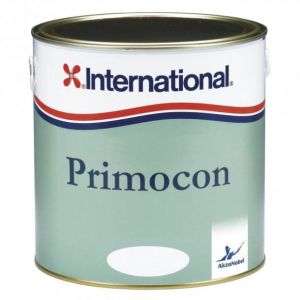
- Sous-couches
- International
- Super Marine
to receive our offers and coupon codes.

- Who are we ?
- Customization Quote
- Crew and Professional Quotation
- Advice sheets and buying guides
- The sailor's corner
- Secure payment
- Shipping costs and time
- Returns and exchanges
- Create an account
- Track your order
- Guarantee and after sales service
- They trust us
- Share your opinion
- Terms and conditions of sale
- Nautisports Gift Card
- Team Fortinet BestWestern

- FR - CGV - Mentions légales - Copyright 2022 - Nautisports.com - TANGO SPORTS

- Sports & Outdoors
- Water Sports
- Maintenance Supplies
- Painting Supplies
Add Extra Protection? Check if this cover meets your needs
- Requirements and requirements declaration: This insurance product has been designed by us based on our many years of experience in the field of property insurance and is intended to protect your belongings in the event of damage. For more sustainability and enjoyment of your products. Please read the product information and insurance terms to confirm that this insurance meets your requirements and needs.
- WHAT IS INSURED AND BENEFITS: Instant protection from purchase of the item, in addition to the manufacturer's warranty/dealer warranty: 2 years worldwide protection against damage caused by dropping or falling, operating errors and defects caused by liquids for products in private use.
- UNINSURED RISKS & EXCLUSIONS: The product is not insured in case of loss, theft or wear. The insurance cover does not apply to persons residing outside Germany or Austria. The insurance cover does not apply to persons under 18 years old.
- Damage: no deductible in the event of damage and no other additional costs at the conclusion of the contract and during the contract term. 93% accepted claims (Jan-Aug 2023): We are happy to assist you with general questions or in case of claim. Use our services after coordination with us the most comfortable and flexible processing for your needs for quick solution finding.
- CONVENIENT TERMS AND CONDITIONS: You have the option to cancel within 45 days of conclusion of the contract. After the 45 days have elapsed, you also have the option to cancel the contract monthly at no additional cost.
- WHAT IS INSURED AND BENEFITS: Instant protection from purchase of the item, in addition to the manufacturer's warranty/dealer warranty: 3 years worldwide protection against damage caused by dropping or falling, operating errors and defects caused by liquids for products in private use.
One-time purchase #buybox .a-accordion .a-accordion-active .a-price[data-a-size=l].reinventPriceAccordionT2 .a-price-whole { font-size: 28px !important; } #buybox .a-accordion .a-accordion-active .a-price[data-a-size=l].reinventPriceAccordionT2 .a-price-fraction, #buybox .a-accordion .a-accordion-active .a-price[data-a-size=l].reinventPriceAccordionT2 .a-price-symbol { top: -0.75em; font-size: 13px; } €34.04 € 34 . 04 €45.39 per l ( €45.39 €45.39 / l) FREE Returns FREE delivery Tomorrow, 13 September . Order within 1 hr 8 mins . Details Only 5 left in stock. .availabilityMoreDetailsIcon { width: 12px; vertical-align: baseline; fill: #969696; } Dispatches from kk-dichtungstechnik Sold by kk-dichtungstechnik Returns Returnable within 30 days of receipt Payment Secure transaction
Return this item for free.
You can return this item for free within 30 days of receipt: no return shipping costs. The item must be returned in new and unused condition.
- Go to ‘Your orders’ to start the return
- Print your label and return authorisation
- Send the item back to us
Choose how often it's delivered
Skip or cancel any time.
- Cancel anytime
Unlock 5% savings
Added to basket.

Image Unavailable

- To view this video download Flash Player
Causes serious eye damage.
Flammable liquid and vapour.
May cause drowsiness or dizziness.
May cause respiratory irritation.
Repeated exposure may cause skin dryness or cracking.
Very toxic to aquatic life with long lasting effects.
Very toxic to aquatic life.
Yachtcare Antifouling SP 750ML - Self-polishing anti-fouling for boats

( €45.39 / l )

( €42.20 / l )

( €53.24 / l )
Purchase options and add-ons
- Highly effective anti-fouling paint – anti-foulings from Yachtcare offer you optimal growth protection all season long.
- Self-polishing anti-fouling for boats - Antifouling SP retains a bioactive surface throughout its life thanks to the self-renewal effect and is compatible with most anti-fouling systems.
- Can be used on almost all surfaces - the underwater coating can be used on GRP, wood and steel. Not suitable for use on aluminium.
- Achieves optimal results - suitable for sailing boats and motor boats. For fast motor boats, we recommend the anti-fouling Yachtcare Action.
- Choose the right shade - the self-polishing anti-fouling from Yachtcare is available in four different shades - blue, black, red and off-white. Use biocidal products carefully. Always read the label and product information before use. Registration number according to the biocide notification regulation: N-74363
Frequently bought together

What do customers buy after viewing this item?

Product information
Technical details.
| Color | blue |
|---|---|
| Size | 0,75l |
| Style | Yachtcare Antifouling SP 750ML - Self-polishing anti-fouling for boats - blue |
| Material Type | Acrylic |
| Seasons | Spring/summer |
| Sport | boating |
| Included Components | YC Antifouling SP |
| Batteries Included? | No |
| Brand | Yachtcare |
| Department | Unisex |
| Manufacturer | YACH7|#Yachtcare |
| Item model number | 154.720 |
| Package Dimensions | 11.4 x 10.4 x 10.4 cm; 750 g |
| ASIN | B07DXW382M |
Additional Information
| Date First Available | 21 Jun 2018 |
|---|---|
| Customer Reviews | 4.7 out of 5 stars |
| Best Sellers Rank | 38,385 in Sports & Outdoors ( ) 37 in |
| Is Discontinued By Manufacturer | No |
Warranty & Support
What's in the box?
- YC Antifouling SP
From the manufacturer

Anti-fouling SP - reliable, powerful anti-fouling.
Yachtcare Antifouling SP is a tin-free, self-polishing anti-fouling. When applying, the surface must be clean, dry and free of grease. When reassembled, first according to Primer specification and apply 2-3 coats of Yachtcare SP. 1-2 renewal coats per season.
To water after min. 6 hours. (20°C) and max. 6 months. (For longer landing times, the anti-fouling should be slightly sanded or cleaned). Areas of use: Fresh,salt and brackish waters.

Yachtcare Antifouling SP is available in two different container sizes.
Choose between 0.75 L and 2.5 L.
For the right look of your underwater boat, we offer you 4 different shades:
- Off White - Blue - Black - Red

Anti-fouling action - reliable, powerful hard anti-fouling.
Anti-fouling action is an effective hard antifouling with insoluble binder.
The underwater fouling protection is suitable for sailing and motor boats in all Northern European waters with medium growth conditions.
Due to the hard, durable surface, it is particularly recommended for fast motor boats, trailer boats or dry marinas.

Yachtcare Action is available in two different container sizes.
Action anti-fouling can be used on all surfaces except aluminium.

| Customer Reviews | |||||
|---|---|---|---|---|---|
| Price | €48.62€48.62 | €39.14€39.14 | €27.30€27.30 | €34.04€34.04 | €37.86€37.86 |
| Type: | Primer / primer. | Primer / primer. | Primer / primer. | Anti-fouling (self-polishing). | Anti-fouling (hard antifouling). |
| Container sizes: | 0.75 L / 2.25 L. | 0.75 L / 2.25 L. | 0.75 L. | 0.75 L / 2.5 L. | 0.75 L / 2.5 L. |
| Consumption | Approx. 7 m² / litre. | Approx. 8 m²/litre per coat. | Approx. 10 m²/litre. | Approx. 13 m²/litre. | Approx. 13 m²/litre. |
| Colours | Grey | White. | Grey | Off white, blue, black, red. | Off white, blue, black, red. |
Looking for specific info?
Customer reviews.
- 5 star 4 star 3 star 2 star 1 star 5 star 77% 18% 3% 1% 2% 77%
- 5 star 4 star 3 star 2 star 1 star 4 star 77% 18% 3% 1% 2% 18%
- 5 star 4 star 3 star 2 star 1 star 3 star 77% 18% 3% 1% 2% 3%
- 5 star 4 star 3 star 2 star 1 star 2 star 77% 18% 3% 1% 2% 1%
- 5 star 4 star 3 star 2 star 1 star 1 star 77% 18% 3% 1% 2% 2%
Customer Reviews, including Product Star Ratings, help customers to learn more about the product and decide whether it is the right product for them.
To calculate the overall star rating and percentage breakdown by star, we don’t use a simple average. Instead, our system considers things like how recent a review is and if the reviewer bought the item on Amazon. It also analyses reviews to verify trustworthiness.
Reviews with images

Sieht gut aus. Lässt sich leicht verarbeiten

- Sort reviews by Top reviews Most recent Top reviews
Top reviews from Germany
There was a problem filtering reviews right now. please try again later..
Product Safety
Product compliance details.
See compliance details for this product ( EU Responsible Person ).
- Press Releases
- Amazon Science
- Sell on Amazon
- Sell on Amazon Business
- Sell on Amazon Handmade
- Associates Programme
- Fulfilment by Amazon
- Supply to Amazon
- Protect and build your brand
- Seller Fulfilled Prime
- Advertise Your Products
- Independently Publish with Us
- Host an Amazon Hub
- › See More Make Money with Us
- Amazon Visa
- Shop with points
- Instalments by Barclays
- Amazon Business Amex Card
- Monthly Invoice
- SEPA Direct Debit
- Amazon Currency Converter
- Top Up Your Account
- Top Up Your Account in Store
- COVID-19 and Amazon
- Track Packages or View Orders
- Delivery Rates & Policies
- Amazon Prime
- Returns & Replacements
- Cancel contracts
- Cancel Vodafone contracts
- Manage Your Content and Devices
- Recalls and Product Safety Alerts
- Amazon Mobile App
- Customer Service
- Accessibility
- Report illegal content
- Conditions of Use & Sale
- Privacy Notice
- Cookies Notice
- Interest-Based Ads Notice

- How to , News
Antifouling for boats: everything you need to know
- Alex Giuzio
- June 17, 2024
Antifouling is designed to protect the hulls of boats from the accumulation of algae and small marine organisms that settle on submerged parts. Beyond aesthetic reasons, antifouling is periodically applied to boats because the long-term buildup of flora and fauna reduces the boat’s performance and can damage the hull. However, there are many different types of this product on the market, and not all boat owners have the necessary knowledge to understand which is the best choice. In fact, antifouling should be selected based on the type of boat and how it is used, as well as the waters in which it sails or is moored. In any case, it’s beneficial for boat owners to have a basic understanding of hull preparation and protection, so they do not rely solely on shipyards. Therefore, we have prepared a comprehensive guide to antifouling for boats, with the help of Gianluca Sansonna from Lechler, which produces a wide range of marine coatings under the Stoppani brand.

Antifouling for boats: what it is and what it used for
Antifouling is a paint coating applied to the submerged part of boats (called the “hull”) to protect it from the settlement of fouling (a term used to describe crustaceans on the hull). “Without this protection, the fouling, by changing the profile and adding weight to the hull, would slow the boat down, increase fuel consumption, and, in some cases, seriously damage the hull”, explains Sansonna.
Like all paint products, antifoulings contain resins, solvents, pigments, and active ingredients (biocidal components). The latter prevent the formation of biological crusts on the hull. Based on the release mechanism of these components, antifoulings can essentially be grouped into two main categories:
Hard Matrix Antifouling : This type releases active ingredients slowly over time, independently of the boat’s movement. It is suitable for both fast boats and those with moderate speed.
Soft Matrix Antifouling (commonly known as “ self-polishing “) : This type releases the paint (not just the biocides) by contact with water during navigation, wearing off with use and thus avoiding the buildup of thickness. By increasing the initial thickness of the paint, the protection time of the antifouling is extended.
The differences in functioning between hard matrix antifouling and self-polishing antifouling are illustrated in the following image.
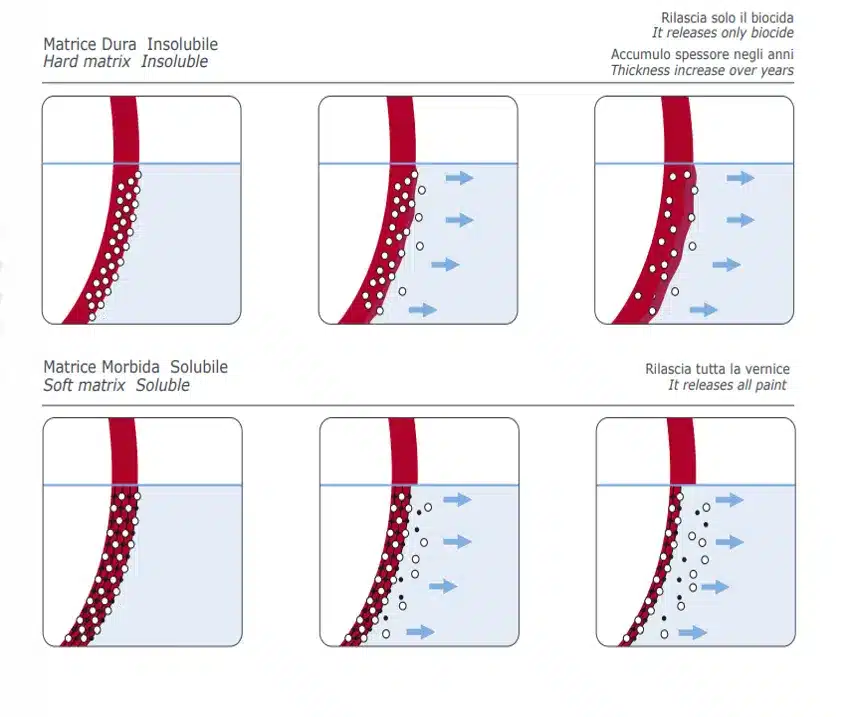
Recommendations for use
Sansonna suggests some precautions for applying antifouling on boat hulls. Here are his recommendations:
Never apply a hard matrix antifouling over a previously applied self-polishing antifouling.
In case of doubt about compatibility or with old antifoulings where compatibility is unknown, apply a coat of primer.
Mix the product well before application.
The application must follow the quantities indicated in the technical data sheet, as applying less than the recommended amount will compromise the duration of the antifouling protection.
Two coats of antifouling are always necessary, with a third reinforcing coat on high-wear areas.
Always adhere to the launching times indicated in the technical data sheet.
Choosing the right antifouling requires considering several factors such as the type of boat, speed, existing products, water quality, and environmental regulations.
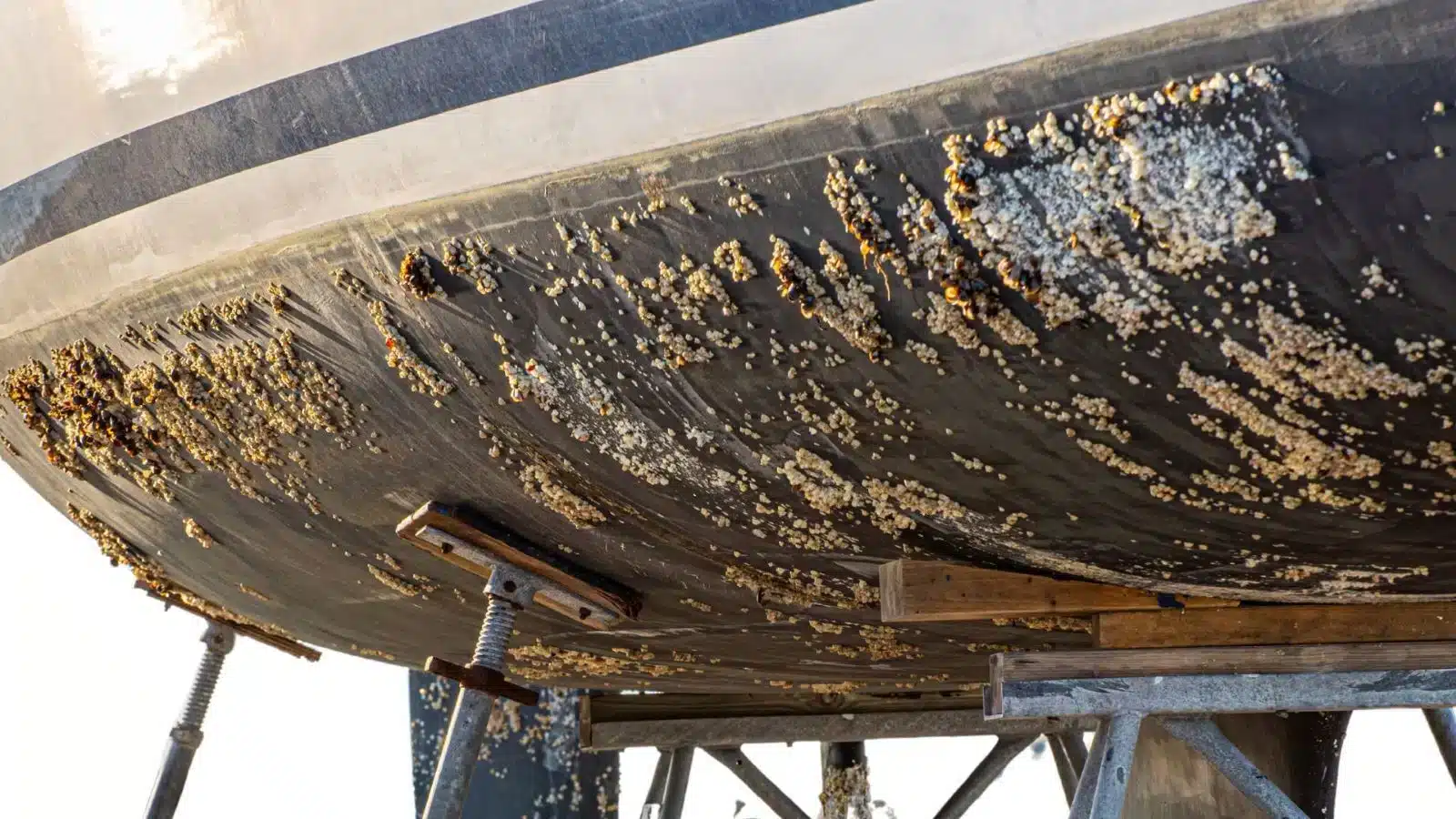
“The boat’s hull should never be left to age, especially if it’s an old wooden hull – emphasizes Sansonna – Therefore, antifouling should be applied to the hull at least every two years. Additionally, there are two situations where it is better to return to the original primer rather than applying a new coat over the existing layer. These situations are when we do not know which antifouling has been previously applied to the hull and when we have a different matrix from the one we want to apply”.
Wood . “Wood continues to hold significant importance in the nautical environment. This is due to its historical tradition (vintage boats) and its natural elegance, which makes it practically irreplaceable in the furnishings and decks of high-end boats. In reality, wood also has a series of technological characteristics that make it an interesting material in the nautical environment. Wood can be considered a natural composite material, sourced from renewable resources, lightweight, economical, and easily workable. The main characteristic to consider when preparing to paint wood with antifouling is the moisture content, which must be below 15%”.
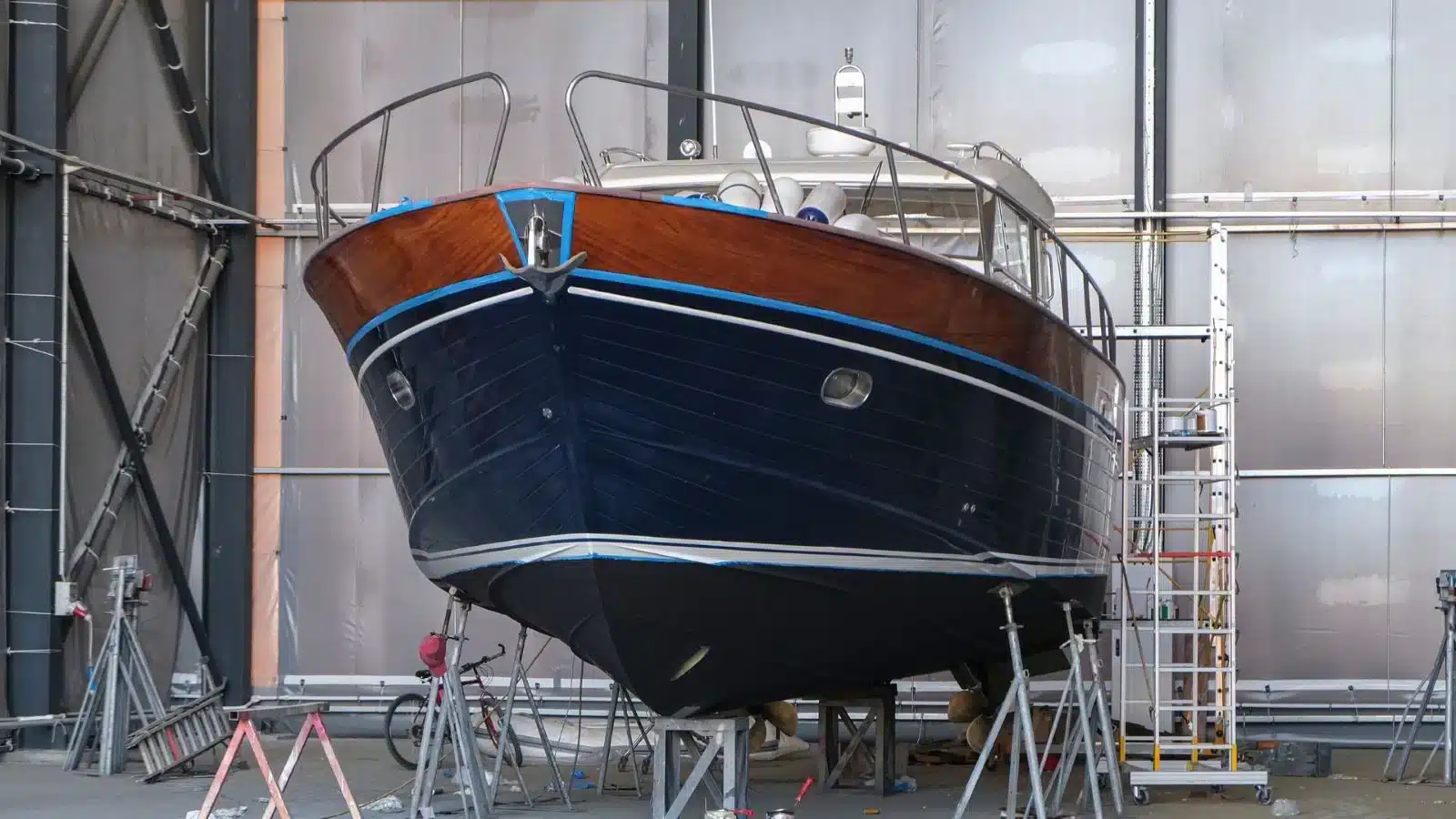
Steel . “Steel is the primary construction material for large vessels and superyachts due to its exceptional strength, ease of workability, and low cost. However, its high specific weight and poor resistance to corrosion are significant drawbacks. Carbon steel is used in shipbuilding, and during the construction phases, the material has no protective coating. In this unprotected state, bare metal quickly oxidizes, so it must be protected with an appropriate epoxy primer immediately after sandblasting”.
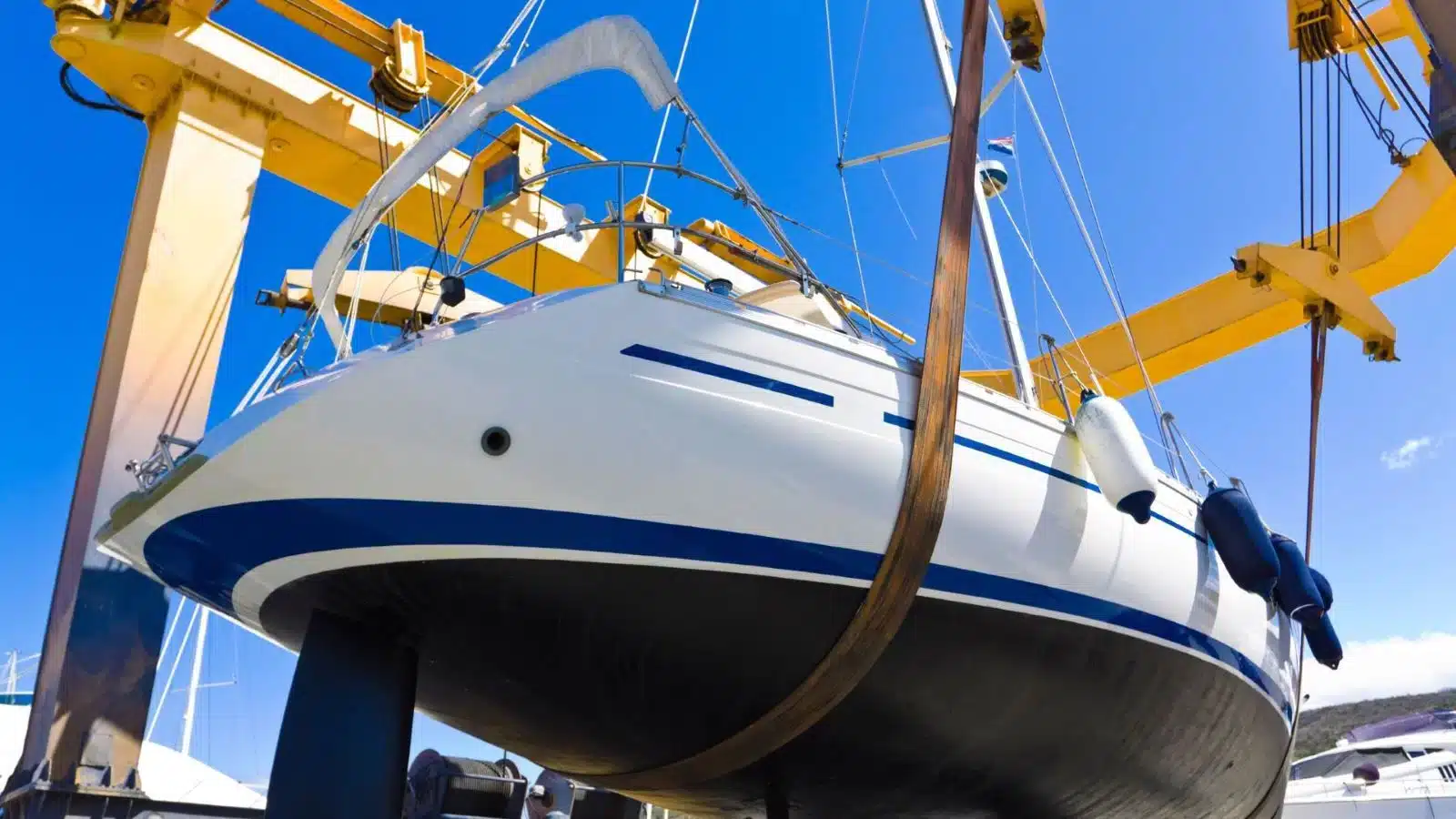
Leave a Reply Cancel reply
Your email address will not be published. Required fields are marked *
Save my name, email, and website in this browser for the next time I comment.
Language switcher
Browse categories.

You might be interested in
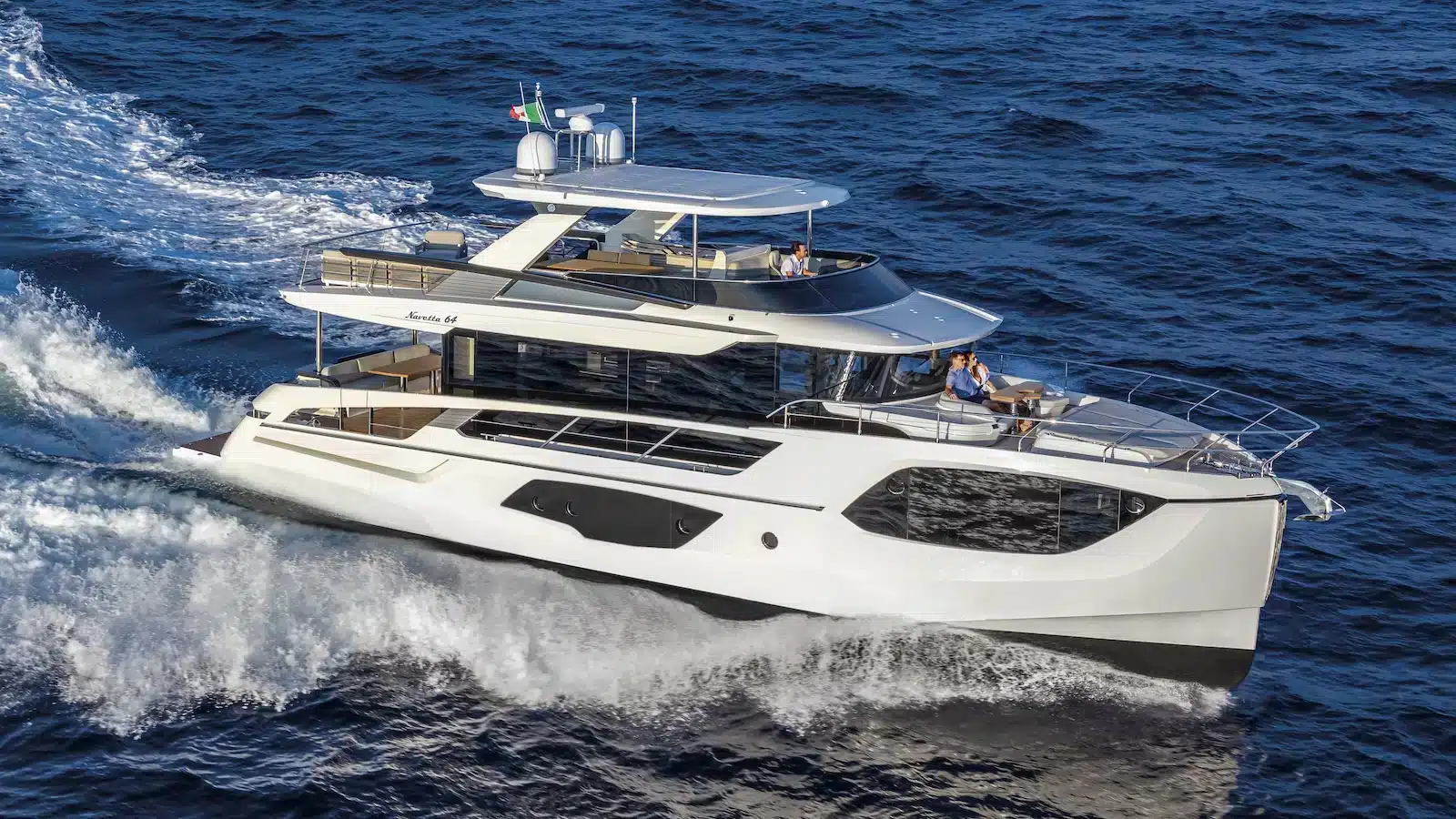
Absolute Yachts at Cannes with a contemporary and innovative collection
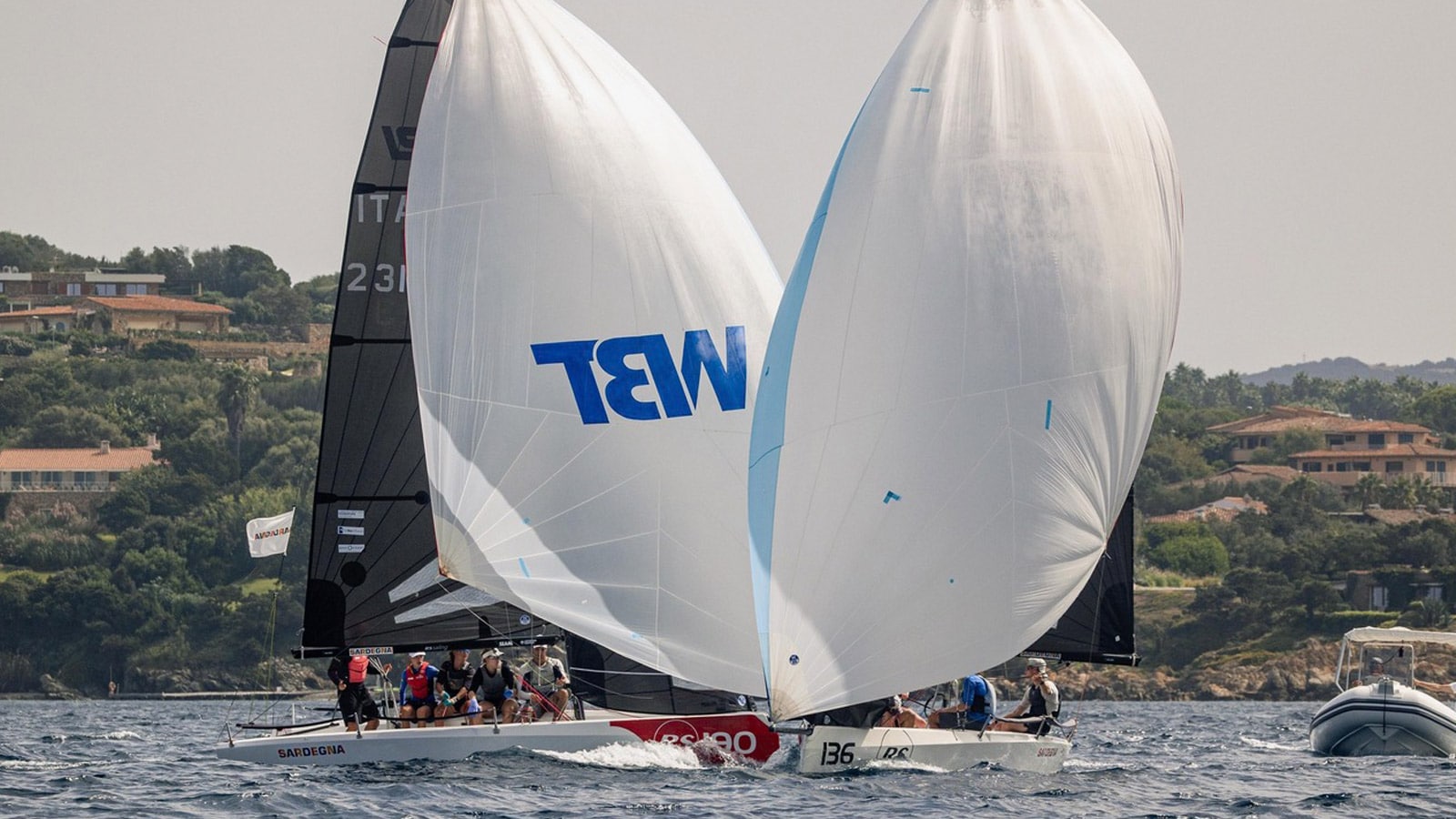
Innovative Sailing World Championship: English crew triumphs
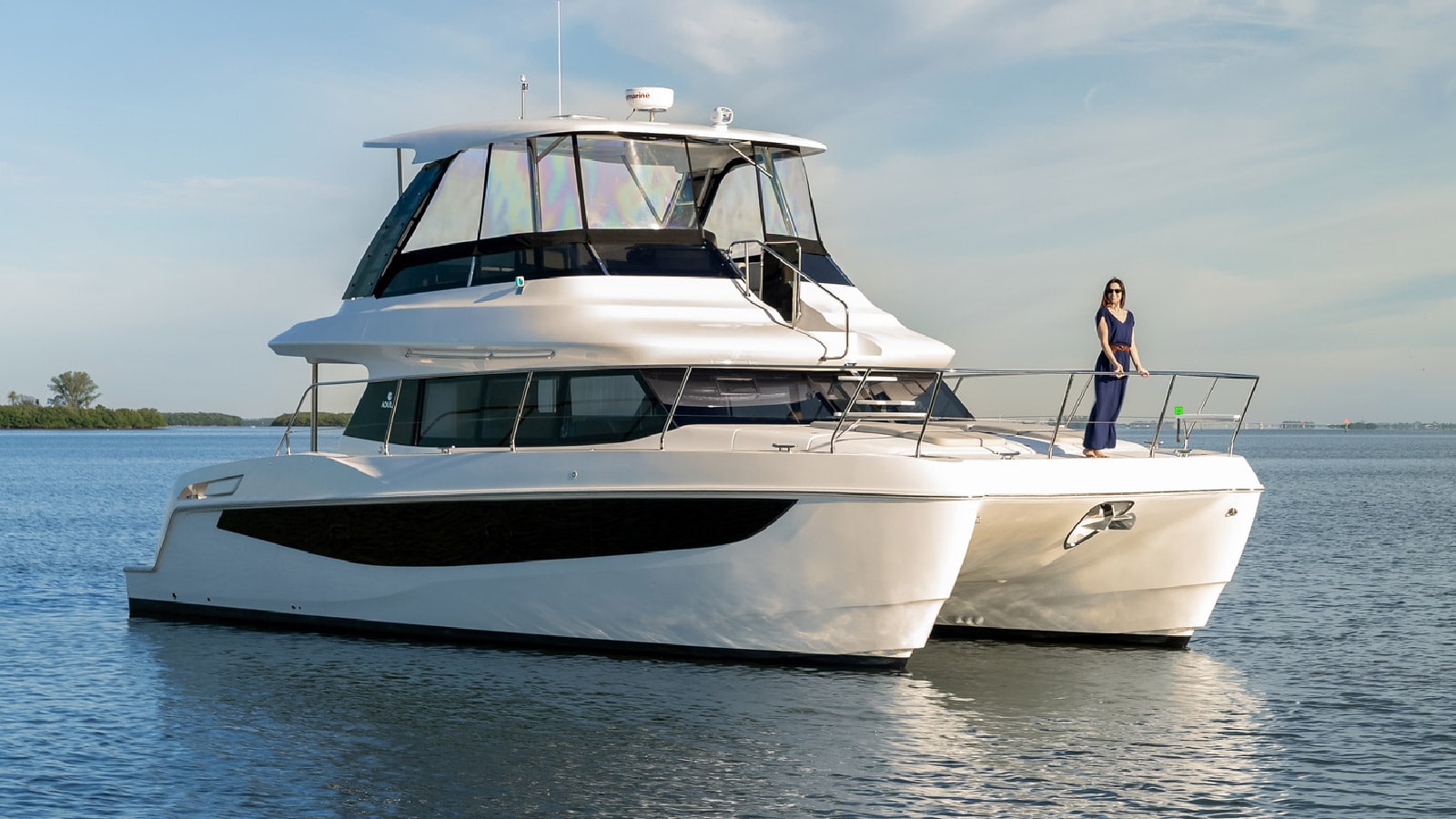
Aquila Power Catamarans conquering Cannes
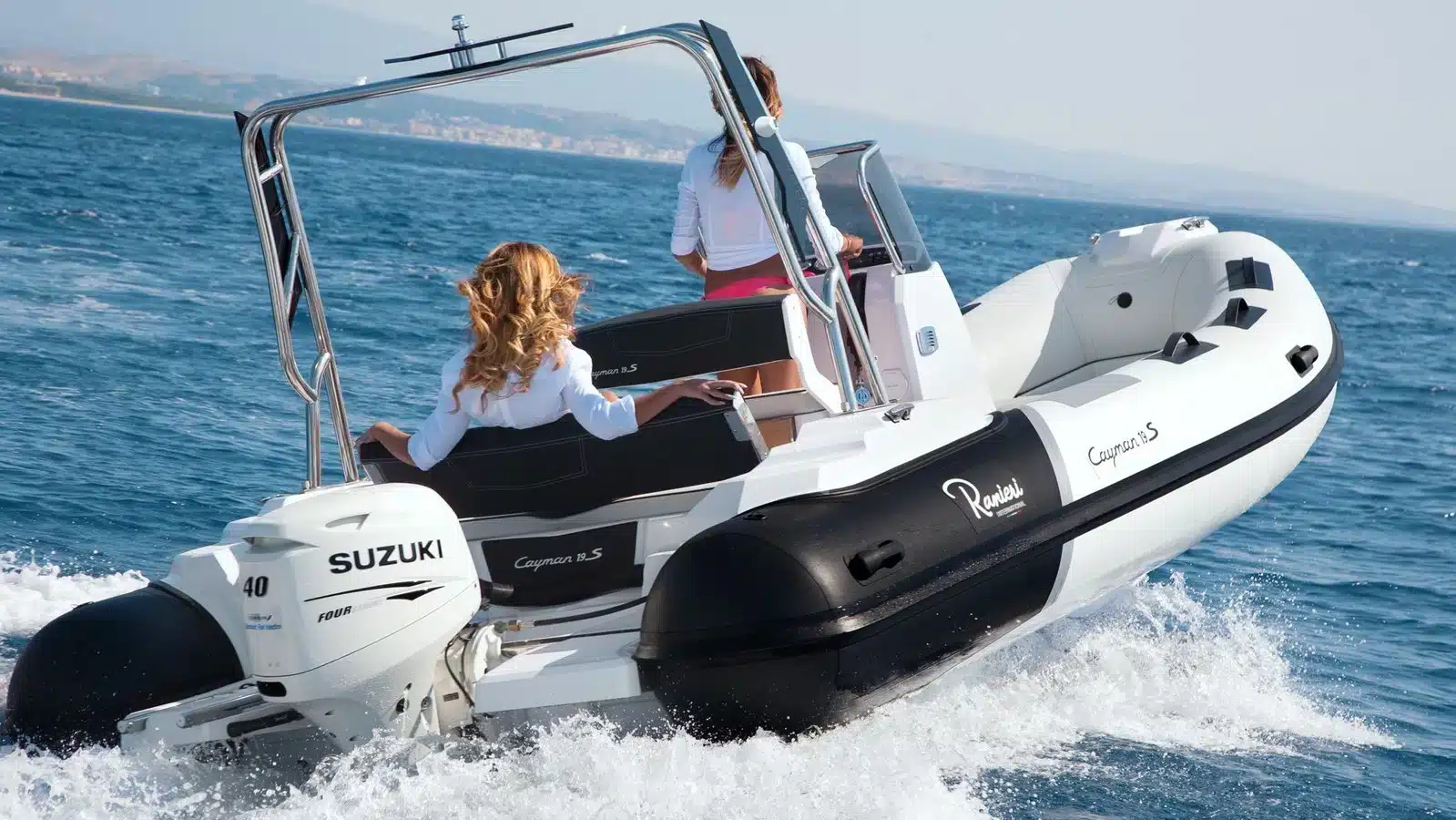
Ranieri Cayman 19 Sport: power and character

© 2021 – THE INTERNATIONAL YACHTING MEDIA Designed by BLive Communication
ABOUT YACHTINGNEWS.COM
Yachting News is an interactive multimedia magazine dedicated to the world of boating.
The International Yachting Media is the worlds most widely read boating magazines network. Whit its portal It broadcast its original contents in five languages and in more than 200 countries developing 950,000 views a week. Our web portals are the main source of information for yacht and boat owners, the place where they can find anything about their boating passion.
THEINTERNATIONALYACHTINGMEDIA.COM | SUPERYACHTS.NEWS | YACHT DIGEST
VIRTUAL BOAT SHOW | TUTTTOBARCHE | TOUSLESBATEAUX | TODOSLOSBARCOS
BOATING NEWS FREE APP

To provide the best experiences, we and our partners use technologies like cookies to store and/or access device information. Consenting to these technologies will allow us and our partners to process personal data such as browsing behavior or unique IDs on this site and show (non-) personalized ads. Not consenting or withdrawing consent, may adversely affect certain features and functions.
Click below to consent to the above or make granular choices. Your choices will be applied to this site only. You can change your settings at any time, including withdrawing your consent, by using the toggles on the Cookie Policy, or by clicking on the manage consent button at the bottom of the screen.
Subscribe For Latest Updates
Sign up to receive the best of Yachting News, sea trials, boat review and world premieres .
The only ADVERTISING FREE newsletter
YACHTCARE HOTLINE (MO-FR): 0800 / 9 22 48 22 73
Händler suche
- Primer / Grundierung
- ANTIFOULING PRIMER
- Produktinformationen
- Technisches Merkblatt
- Sicherheitsdatenblatt
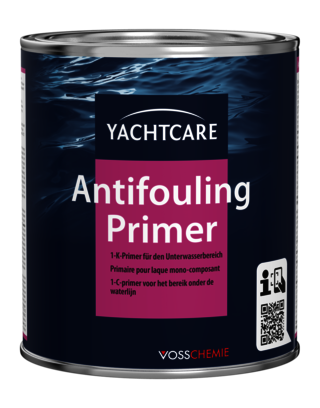
Antifouling Primer
ANTIFOULING PRIMER ist eine einkomponentige, elastische Grundierung zur Beschichtung des Unterwasserbereiches. Die im Primer enthaltenen Metallplättchen bilden ein Schuppengeflecht, das einen hochwertigen Schutz gegen eindringende Feuchtigkeit auf GFK, Holz oder metallischen Untergründen bietet. Der Primer ist für eine dauerhafte Wasserbelastung geeignet und als Folgeanstriche sind Antifoulings zu verwenden.
ANTIFOULING PRIMER eignet sich auch hervorragend als Sperrprimer und Haftvermittler bei einem Antifoulingwechsel.
Achtung: Nicht geeignet als Primer für Dünnschicht-Antifoulings.
Materialdaten
- Inhalt: 750 ml
- Farbton: matt grau
- Ergiebigkeit: ca. 10 m² / l
- Spez. Gewicht: ca. 1,2 kg/l
YACHTCARE hard antifouling ACTION

Prices incl. VAT plus shipping costs
Economical and effective hard antifouling with copper bonding as active component and an indissoluble binder. As such it offers excellent antifouling protection especially for speed boats, trailer boats and boats that fall dry in tidal waters. Developed for the north European coastal and inland waters. Apart from aluminium it can be applied on all surfaces and boat materials. Yield: 13m²/l. Use biocide products safely. Always read the label and product information before use.
- Do you have any questions concerning this product?
| Article-No. | Packaging | Colour | Article | Price (Can) | Delivery | Quantity | |
| 750 ml can | red | Art.Nr.: 2520-801 packaging: 750 ml can colour: red €35.90* 0.75 l ( €47.87 * / 1 l ) In stock. | 0.75 l ( €47.87 * / 1 l ) | In stock. | |||
| 2,5 litre can | red | Art.Nr.: 2520-802 colour: red packaging: 2,5 litre can €95.50* 2.5 l ( €38.20 * / 1 l ) In stock. | 2.5 l ( €38.20 * / 1 l ) | In stock. | |||
| 750 ml can | black | Art.Nr.: 2520-803 packaging: 750 ml can colour: black €35.90* 0.75 l ( €47.87 * / 1 l ) In stock. | 0.75 l ( €47.87 * / 1 l ) | In stock. | |||
| 2,5 litre can | black | Art.Nr.: 2520-804 colour: black packaging: 2,5 litre can €95.50* 2.5 l ( €38.20 * / 1 l ) In stock. | 2.5 l ( €38.20 * / 1 l ) | In stock. | |||
| 750 ml can | blue | Art.Nr.: 2520-805 colour: blue packaging: 750 ml can €35.90* 0.75 l ( €47.87 * / 1 l ) In stock. | 0.75 l ( €47.87 * / 1 l ) | In stock. | |||
| 2,5 litre can | blue | Art.Nr.: 2520-806 colour: blue packaging: 2,5 litre can €95.50* 2.5 l ( €38.20 * / 1 l ) In stock. | 2.5 l ( €38.20 * / 1 l ) | In stock. |
- PDF: Technisches Datenblatt DE
- PDF: Yachtcare Handbuch Antifouling DE
- Artikel im TOPLICHT-Katalog auf Seite 269 ansehen
- View article in TOPLICHT catalog on page 269
- Ratgeber Antifouling
- Antifouling Guide

COMMENTS
YACHTCARE Antifouling Primer. From €26.90 *. Prices incl. VAT plus shipping costs. An elastic, one component primer for the underwater coating of GRP, metal and wood. The metal particles in the primer generate a flake netting, which constitutes a robust protection against immersive moisture. The primer forms an underground for all ...
YACHTCARE ANTIFOULING PRIMER: PREPARE, PROTECT, PRESERVE Yachtcare Antifouling Primer is a single-component primer enriched with aluminum pigments. It acts as an essential interface between an existing and a new antifouling, especially when the nature of the previous treatment is unknown. By forming an impermeable barrier, this product effectively protects submerged wood, iron and polyester ...
YACHTCARE Aluminium Grey Antifouling Primer - 750ml, This is a one-component primer containing aluminium pigments that act as an interface between old and new-Yield: 8m2/l (at 50u dry per coat) Capacity: 750ml Packaging : 1 x Antifouling primer grey aluminium YACHTCARE - 750ml Delivered in its original packaging-750ml-Aluminium gray
If your existing paint is flaking, you need to prime any bare or flaky patches. Scrape away until all the flaky paint has come off, then feather the edges by wet sanding them. Generally speaking, self-eroding antifouling can be safely applied over the top of hard, but applying hard on self-eroding should be avoided.
Not suitable as a primer for thin-film anti-fouling. Areas of application: the anti-fouling primer from Yachtcare is ideal as a barrier primer and adhesion promoter for an anti-fouling change. Compatible - as a subsequent coat, we recommend the use of a high-quality hard or self-polishing antifouling from the house after priming. Yachtcare.
Use a coarse grade of wet/dry sandpaper, 40-60 grit, and water and sand the entire area you are painting. As soon as the sandpaper loses bite, rinse or replace it. Step 4. If you have to use Primer as some areas need stripping back, check it's compatible with both the old and the new antifoul.
Reviews Thinner Yachtcare Primer and Antifouling paint * We found other products you might like! Thinner BOERO 703. Regular Price $17.50-26%. Starting at $12.99. ThinnerInternational . Starting at $12.50. Thinner Veneziani 6470. Regular Price $13.00-24%. Starting at $9.90. Thinner Yachtcare Lacquer. Regular ...
YACHTCARE Grey Antifouling Primer - 750ml : Amazon.co.uk: Sports & Outdoors. Skip to main content.co.uk. Delivering to London W1D 7 Update location DIY & Tools. Select the department you ...
Shop Yacht Care Epoxy Primer - for Anti-fouling Paint and Varnish, Unisex, Epoxy Primer, White, ... Yachtcare : Department unisex : Manufacturer YACH7|#Yachtcare : Item model number 150.969 : Product Dimensions 10 x 10 x 18.2 cm; 934 g : ASIN B00PFT7VLM : Additional Information.
YACHTCARE SP Self Polishing Antifouling. A self-polishing antifouling with copper bindings and bioactive, organic active ingredients. Intended for use in fresh, salt and brackish water. ... YACHTCARE Antifouling Primer . Content 0.75 Liter (€35.87 * / 1 Liter) from €26.90 . YACHTCARE EPOXY primer . Content 0.75 Liter (€39.87 * / 1 Liter)
Primer is the first coat to be applied before painting your boat, followed by the undercoat. ... Yachtcare Yachtcare antifouling primer. €24.00. Yachtcare Yachtcare epoxy primer. €30.00. Yachtcare Yachtcare marine primer. €21.00. Yachtcare Yachtcare anti-osmosis primer. €192.00.
Overview : Presentation : With the YACHTCARE primer and antifouling kit for propellers and bases - black- 2x 400 ml, you have a base coat which is the primer and an antifouling ( the paint), both specially designed for your propellers and bases. In aerosol, the application in difficult to reach areas is very easy and very homogeneous on the whole metal surface.
Size: 0,75l. Colour: blue. Highly effective anti-fouling paint - anti-foulings from Yachtcare offer you optimal growth protection all season long. Self-polishing anti-fouling for boats - Antifouling SP retains a bioactive surface throughout its life thanks to the self-renewal effect and is compatible with most anti-fouling systems.
It should only be used when the YACHTCARE antifouling primer is too viscous, for instance at low temperatures. Compare . Wish List. Do you have any questions concerning this product? Article-No. Packaging: Article: Price (Can) Delivery: Quantity: 2520-019 : 750 ml can: YC-COATING THINNER 750ml für Antifouling-Primer
Alex Giuzio. June 17, 2024. Antifouling is designed to protect the hulls of boats from the accumulation of algae and small marine organisms that settle on submerged parts. Beyond aesthetic reasons, antifouling is periodically applied to boats because the long-term buildup of flora and fauna reduces the boat's performance and can damage the hull.
Der Primer ist für eine dauerhafte Wasserbelastung geeignet und als Folgeanstriche sind Antifoulings zu verwenden. ANTIFOULING PRIMER eignet sich auch hervorragend als Sperrprimer und Haftvermittler bei einem Antifoulingwechsel. Achtung: Nicht geeignet als Primer für Dünnschicht-Antifoulings. Materialdaten. Spez. Gewicht: ca. 1,2 kg/l.
Yachtcare Primer Antifouling kaufen bei BAUHAUS: Grau, Matt, 750 ml Online bestellen oder Reservieren & Abholen im Fachcentrum In Ihrem Browser ist JavaScript deaktiviert. Um unseren Online-Shop nutzen zu können, aktivieren Sie JavaScript innerhalb Ihrer Browsereinstellungen.
Single-component primer for interfacing old and new antifouling
YACHTCARE EPOXY-PRIMER can be coated over by all antifoulings and paint systems. Yield: 8 m²/l. Compare . Wish List. ... YACHTCARE Antifouling Primer . Content 0.75 Liter (€35.87 * / 1 Liter) from €26.90 . Epoxy-Primer SEAJET 117 Multipurpose . Content 1 Liter . from €53.90 .
YACHTCARE hard antifouling ACTION. From €35.90 *. Prices incl. VAT plus shipping costs. Economical and effective hard antifouling with copper bonding as active component and an indissoluble binder. As such it offers excellent antifouling protection especially for speed boats, trailer boats and boats that fall dry in tidal waters.
Yachtcare Antifouling Primer Version 1.1 DE / DE Überarbeitet am: 28.11.2019 Datum der letzten Ausgabe: 13.11.2019 Datum der ersten Ausgabe: 13.11.2019 1 / 27 ABSCHNITT 1: Bezeichnung des Stoffs beziehungsweise des Gemischs und des Un-ternehmens 1.1 Produktidentifikator Handelsname : Yachtcare Antifouling Primer Produktnummer : 156.391
Yachtcare Primer Antifouling kaufen bei BAUHAUS: Grau, Matt, 2,5 l Online bestellen oder Reservieren & Abholen im Fachcentrum In Ihrem Browser ist JavaScript deaktiviert. Um unseren Online-Shop nutzen zu können, aktivieren Sie JavaScript innerhalb Ihrer Browsereinstellungen.